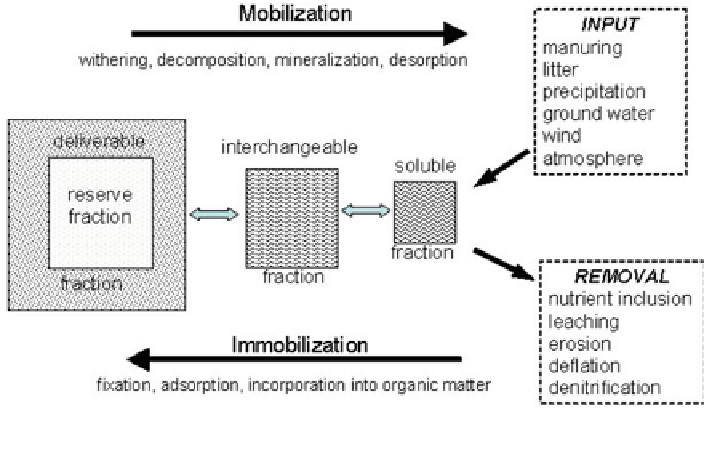Geoscience Reference
In-Depth Information
Fig. 3.2 Nutrient behavior in soils under human in
uence (Adapted from Kuntze et al.
1994
)
Nutrient balances are the sum of several dynamic equilibria, with (1) fertilization
and deposition from the atmosphere as external input parameters, (2) mineralization
as most important factor particular to the soil and (3) nutrient export by harvesting
products and through various kinds of removal such as leaching or wind erosion.
The other factor particular to the soil type is the rate of immobilization. Their
interplay results in the fertility at a given point and place.
The chemist Justus von Liebig (1803
1873) played an epochal role in the
development of soil nutrition. He popularized a
-
“
Law of the Minimum
”
, stating that
if one crop nutrient is missing or de
cient, plant growth will be poor, even if the
other elements are abundant. This is not surprising. Just like humans, plants require
a balanced diet. Apart from carbon, the basic building block of life, the main
elements they require are nitrogen, potassium and phosphorus, sulfur, magnesium
and calcium. Plants also require a whole array of micro-nutrients. Modern fertilizers
are tuned to different crops by their micro-nutrient content. Just like humans, plants
can get too much of a good thing, too: especially sodium ions are stressful for many
plants, with the exception of salt-tolerant, halophytic species such as date palms or
barley. Salinization, the buildup of high sodium chloride levels, often a conse-
quence of irrigation, therefore threatens yields.
3.2.2 Soil Functions and Threats to Soils
Soils perform several key functions, apart from their role in biomass production.
They are
lters and buffers and perform transformations between the atmosphere,
the ground water and the plant cover, strongly in
uencing the water cycle at the

